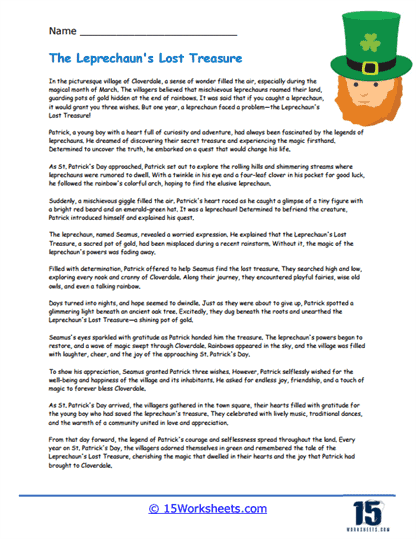Saint Patrick's Day Worksheets
All About These 15 Worksheets
This series of 15 worksheets is an engaging and educational resource designed to celebrate and learn about the traditions, symbols, and history of Saint Patrick’s Day. These worksheets provide students with an opportunity to explore the cultural significance of this holiday and develop a deeper understanding of Irish heritage. By completing a variety of activities, they will deepen their knowledge of Saint Patrick’s Day, foster creativity, and engage in cross-curricular learning. Through these worksheets, students will:
- Enrich their vocabulary by answering a variety of word exercises with words or terminologies related to Saint Patrick’s Day, like Unscramble Words, Counting of Syllables, matching exercises, and more;
- Demonstrate their knowledge on the origins and traditions of Saint Patrick’s Day through true or false questions, fill in the blanks, and varied writing prompts;
- And understand the significance of the shamrock, leprechaun, and other symbols.
This series provides an immersive and educational resource for students to celebrate and learn about the traditions, symbols, and history of Saint Patrick’s Day. Through activities encompassing historical context, symbols and traditions, Irish culture, vocabulary, creative writing, and crafts, students will deepen their understanding, foster creativity, and engage in cross-curricular learning. In summary, these worksheets promote cultural appreciation, creativity, and inspire students to celebrate the rich heritage of Saint Patrick’s Day.
What is Saint Patrick’s Day?
Saint Patrick’s Day, also known as St. Paddy’s Day or St. Patrick’s Day, is a cultural and religious holiday celebrated on March 17th each year. The holiday commemorates Saint Patrick, the patron saint of Ireland, and the arrival of Christianity in Ireland. It is also a celebration of Irish heritage and culture.
Saint Patrick was a 5th-century Christian missionary and bishop in Ireland. He is credited with converting many Irish people to Christianity during his time there. Although not much is known about his life, many legends and stories are associated with him, such as the tale of him driving all the snakes out of Ireland and using the shamrock, a three-leafed plant, to explain the concept of the Holy Trinity (the Father, the Son, and the Holy Spirit) to the Irish people.
Saint Patrick’s Day was initially a religious observance in Ireland, marked by feasts and special church services. Over time, it has evolved into a more secular celebration of Irish culture, particularly among the Irish diaspora in countries such as the United States, Canada, and Australia. The day is often marked by parades, music, dancing, and the wearing of green clothing or accessories. The shamrock, which is associated with Saint Patrick, has become a symbol of the holiday and is often worn or displayed during celebrations.
In addition to wearing green, many people around the world celebrate Saint Patrick’s Day by attending Irish-themed events, eating traditional Irish food, and participating in activities such as pub crawls or parties. The holiday serves as an opportunity to honor Irish heritage, learn about Irish history and culture, and enjoy the company of friends and family in a festive atmosphere.

















